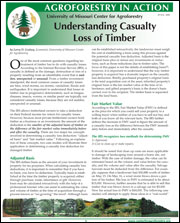Editor's note
The following abstract describes a publication that is only available as a downloadable PDF.
One of the most common questions regarding tax treatment of timber has to do with casualty losses -- the damage, destruction or loss of a property resulting from an identifiable event that is sudden, unexpected or unusual. From a timber investment standpoint, the most common causes of casualty losses are fires, wind storms, ice storms, vandalism, floods and earthquakes. It is important to understand that losses in timber due to progressive deterioration, such as fungus, diseases, insects, worms, or similar pests are typically not considered casualty losses, because they are not sudden, unexpected or unusual. The IRS allows timberland owners to take a deduction on their Federal income tax return for casualty losses. Two major tax concepts are involved in determining a casualty loss deduction: “adjusted basis” and “fair market value.” This guide is an explanation of these concepts and two case studies illustrating their application in determining a casualty loss deduction for damaged timber.
Topics
- Casualty loss
- Adjusted basis
- Fair market value
Pages
12
 Larry Godsey
Larry Godsey